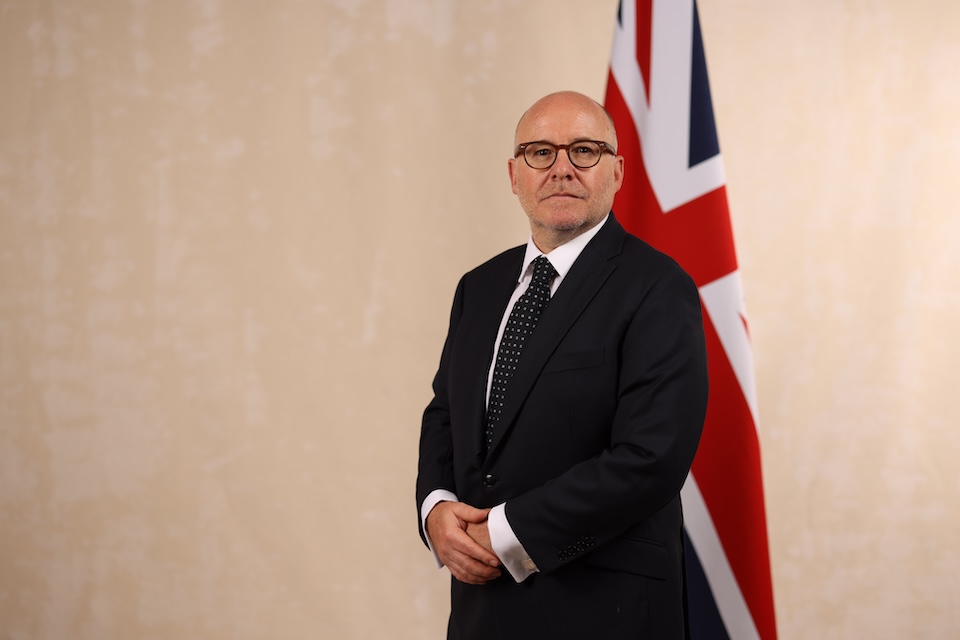Please note the political content has been removed from this speech.
Today, we are in Southwark, the home of London’s probation service, one of the busiest in the country.
Here in London, the Service supervises more than 36,000 offenders.
And, every day, in this building, there are a thousand untold stories of how our probation service protects the public and makes our streets safer.
I want to talk about the future of our probation service today.
But to look to that future, I think we must first look to the past.
Because it was here, in Southwark, that the probation service first took root.
Over 150 years ago, the Church of England’s temperance movement posted a man called George Nelson to Southwark’s police court.
Nelson was the first of a band of missionaries, driven by their faith and strict teetotalism, who gave up their time to help offenders give up the drink.
Addiction then, as addiction now, drove much criminal behaviour…
And the approach worked.
In fact, it worked so well that the courts came to rely on missionaries like Nelson.
A system soon developed where offenders would be released on the condition that they kept in touch with these volunteers.
Because what began as a moral cause proved to have a practical purpose
These missionaries led to less crime and fewer victims.
As this Government might say they made our streets safer.
By the early twentieth century, this voluntary service was so greatly valued that it was placed on a statutory footing.
The 1907 Probation of Offenders Act established the first formal structure for probation…
And the volunteers became professionals.
In the years that followed, the service grew
The 1925 Criminal Justice Act paid probation officers a regular wage.
By the 1950s, probation’s work expanded to offenders on parole.
And by the 1980s, the service was focused increasingly on prison releases.
Over time, the role developed.
Where the early missionaries were focused on crimes driven by addiction…
In time, they took responsibility for the management of ever more, and ever more complex, offenders.
Too often overlooked, with our focus invariably falling on the police or on prisons…
Probation became an indispensable part of a criminal justice system that keeps us safe.
It remains so today, now a service that is more than 20,000 strong…
And probation officers supervise almost a quarter of a million offenders – around three times the number currently serving time in our prisons.
Each year, they oversee more than 4 million hours of community payback.
They monitor around 9,000 offenders on a tag at any given moment.
They provide sentencing advice to hundreds of courts every single day.
And they also provide a vital link to tens of thousands of victims, through the Victim Contact and the Victim Notification schemes.
But while there have been bright moments in the service’s past, we must acknowledge the dark days too.
In 2014 the service was split
Part remained in the public sector, managing the highest-risk offenders.
The rest was hived off, to be run by the private sector, who would supervise those of low and medium risk.
Community Rehabilitation Companies would bring the ingenuity of the private sector to solve the problem of reoffending.
The rhetoric was of a revolution in how we manage offenders.
The reality was far different.
Workloads increased, as new offenders were brought under supervision for the first time…
The number of people on probation increased between December 2014 and December 2016, with almost 50,000 offenders newly under its remit.
Scarce resources were stretched further than ever…
Morale plummeted.
And worrying numbers voted with their feet, leaving the service altogether…
With the Inspector of Probation declaring a “national shortage” of probation professionals in 2019.
The new companies woefully underperformed.
Between 2017 and 2018, just 5 of 37 audits carried out by HMPPS demonstrated that expected standards were being met.
In 2019, 8 out of 10 companies inspected received the lowest possible rating – “inadequate” – for supervising offenders.
The Chief Inspector called them “irredeemably flawed”.
And the service was labelled ‘inadequate’.
In 2021, it was finally, rightly, re-unified and re-nationalised.
Now, make no mistake…
Every day, across the country, probation staff make this country safer.
This was clearly evident in the service’s response to the prison capacity crisis.
With prisons just days from collapse, this Government was forced to introduce an emergency release programme, which saw some offenders leave prison a few weeks or months early.
The alternative, as I said at the time, did not bear thinking about
We would have been forced to shut the front door of our prisons…
An act that would have sent dominoes tumbling through our justice system
Courts unable to hold trials…
Police forced to halt arrests…
And the eventual path to a total breakdown of law and order.
In making that decision, I knew the probation service would have to carry an even heavier load.
They would have to put in place plans for the safe release of prisoners in just a few weeks.
I tried to give them as much time as I possibly could to prepare
An eight-week implementation period.
It wasn’t long to prepare, but the probation service used it with great skill.
But now is also a moment to be honest about the challenges the service faces.
And the simple fact is this
The service was burdened with a workload that was, quite simply, impossible.
When we took office, we discovered that orders handed out by courts were not taking place.
In the 3 years to March 2024 around 13,000 Accredited Programmes, a type of rehabilitative course, did not happen.
This wasn’t because an offender had failed to do what was expected of them…
But instead because the Probation Service had been unable to deliver these courses.
As I have shown already in this job, I believe in confronting problems, not pretending they are not there.
And so, we will ensure only those offenders who pose a higher risk, and who need to receive these courses, will do so.
This isn’t a decision I take lightly.
But it is a decision to confront the reality of the challenges facing the probation service.
I should be clear
For those who will not complete an accredited programme, they remain under the supervision of a probation officer…
And all the other requirements placed upon them will remain in place.
Any breach of a community sentence could see them hauled back into court.
Any breach of a licence condition could see them back behind bars.
Addressing individual issues like these, however, is no long-term solution to the challenges the probation service faces.
Today, across the country, probation officers are spread too thin – responsible for caseloads and workloads that exceed what they should be expected to handle.
Probation officers are drawn to the profession not because it is just another job.
This job is a vocation, even a calling…
They are, after all, the inheritors of those missionaries of 150 years ago.
They are experts in their discipline…
Who want to know that their work is protecting the public…
And keeping offenders on the straight and narrow.
Over-stretched, they can’t work with offenders in the way they need to.
And the burden placed on probation officers’ shoulders grow heavier and heavier.
It has driven people away from the job…
It has made the public less safe…
And it has to change.
It is clear we need to bring more people into the probation service.
In July, I committed to bringing on 1,000 trainee probation officers by March of this year.
But we must go further.
Today, I can announce that, next year, we will bring on at least 1,300 new, trainee probation officers.
New probation officers are the lifeblood of the service, and they will guarantee its future.
But they are not enough alone.
It is also clear we must remove the administrative burden that weighs probation officers down…
And makes them less effective in their roles.
Today, too many hours of probation officer time are wasted each day.
They are drowning in paperwork.
And I don’t mean metaphorical paperwork.
I mean literal pen and paperwork.
This takes up valuable time, that would be better spent working with offenders…
And it also introduces the risk of error – the failure to identify the critical piece of information that might shape a professional’s judgement of the risk that an offender poses.
Where digital processes do exist in the probation service, they can be difficult to navigate.
Information is stored in multiple different systems that do not speak to each other.
And probation officers are forced, laboriously, to type the same information time and again.
We will soon pilot a digital tool that will put all the information a probation officer needs to know into one place.
Over time, this will include information from other agencies, like the police as we need to make sure data is more readily shared, so that probation can make better decisions.
We’re also trialling a new system for risk assessing offenders, to make it more straightforward for probation officers to make robust decisions.
A group of officers in Brighton started using this in December last year…
And we estimate it will cut up to 20 percent of the time it takes to do this crucial activity.
It might sound simple, but the impact could be considerable.
Every minute saved is more time probation officers can spend working with offenders.
Less simple, but even more transformational, there’s the potential of artificial intelligence.
We are currently looking into voice transcription.
This would automatically record and transcribe supervision conversations by taking notes in real time…
Allowing probation officers to focus on building relationships, while also removing the need for them to enter handwritten notes into a computer afterwards.
In time, we believe that AI could play a more active role in supporting staff to supervise offenders – for example, drawing on the data we have on an offender to suggest a supervision plan tailored to them.
This new technology will ensure probation officers provide what only they can
The human factor.
The ability to work with an offender, one-to-one, to understand the risk they pose…
To develop a plan for how to manage it…
Ultimately, to turn them away from a life of crime – and so protect the public.
That is what remains true about the probation officer’s job now, just as it was 150 years ago.
The courts didn’t turn to the temperance movement’s missionaries because they were great at paperwork.
They did so because of how they worked with offenders.
They knew – in the words of the Government Minister who brought in the 1907 Probation Act – how “to guide and admonish” an offender to make the public safer.
But while new staff and better technology are necessary to the future of our probation service…
They are not sufficient.
With a caseload of nearly a quarter of a million offenders…
We must also look at the work that probation officers are doing…
And we must ask
Where should their time be spent…
And, more specifically, who should their time be spent with to have the greatest impact?
In this, it is clear there are two types of offender.
On the one hand, we have those who pose a higher risk to society.
In this group, we have those who are dangerous – posing a real risk of harm to the public.
We also have those whose offending is prolific – the one in every ten offenders who is guilty of nearly half of all sentenced crime.
On the other hand, we have offenders who pose a lower risk.
They are not serial offenders, with a high risk of reoffending.
Their crimes are instead often fuelled by addiction, homelessness, and joblessness.
These crimes are not excusable.
All crimes must be punished.
But these two groups – the higher and lower risk – are different.
If we want to reduce reoffending, cut crime and have safer streets, we have to treat them differently.
And too often today, we don’t.
We have a one size fits all approach.
That must change.
For higher-risk offenders, a probation officer’s time and focus is essential.
It is no exaggeration to say that effective supervision of this cohort can be the difference between life and death.
We all know the tragedies
I think of Terri Harris, her children John Paul and Lacey Bennett and Lacey’s friend Connie Gent, savagely murdered by Damien Bendall in 2021, when Bendall was serving a community sentence.
And I think of Zara Aleena, murdered by Jordan McSweeney in 2022, just nine days after he had left prison on licence.
We will never be able to stop every tragedy.
But we have to stop more.
There are improvements that we can and must make to the processes probation officers follow, and the technology they use.
We have introduced new training, to better identify risk…
New digital tools, as I have mentioned already, will draw together the critical pieces of information from partner organisations, like the police.
But the vital ingredient is time
The time of a professional probation officer…
Devoted to identifying the risk an offender poses…
Creating a plan to manage it…
And supervising, closely, that offender to ensure they do not deviate from it.
That is the human factor that only a probation officer can provide.
If probation officers are to have this valuable time with these offenders, we must be more efficient with the time they devote to lower-risk offenders.
At the very end of their time in office, my predecessor introduced a policy called Probation Reset.
This saw supervision of lower-risk offenders end after two-thirds of their licence period.
This was a step in the right direction.
The interventions that work best with lower risk offenders are not necessarily those provided by probation officers.
So that is where we must now direct the attention of their supervision.
We need to get these offenders off drugs and booze – reoffending rates are 19 points lower when an offender completes a drug treatment programme.
We need to ensure they have a roof over their heads – reoffending rates double for those released homeless.
And finally, we need to get them working – reoffending rates are up to 9 points lower when an offender is employed.
The probation service has a role to play here…
But their unique value is in referring offenders to the intervention that is required to address the cause of their offending.
And so today, I can announce that we will build on the work of Reset.
This Government will focus the probation service on the interventions that have the greater impact.
For lower risk offenders, we will task probation officers with providing a swifter intervention.
They will spend more time with an offender immediately after their release
First, assessing the root causes of an offender’s crime…
Then referring them to the services that will address that behaviour
Which could be education, training, drug treatment or accommodation…
Delivered by the probation service, our partners across Government, and through the brilliant work done by the voluntary sector.
Once offenders are following that direction, as long as the offender stays on the straight and narrow, we must then focus probation officer’s time more effectively
That means more time spent with the offenders who pose the greater risk…
More time with offenders who pose a risk of a serious and violent further offence…
And more time with offenders whose prolific offending causes so much social and economic damage to local communities.
That is how we will reduce reoffending…
That is how we will cut crime…
And that is how we will make our streets safer.
These measures are necessary today, but they will be even more important in the months and years to come.
David Gauke’s independent review of sentencing will report soon.
He has been asked to ensure we never run out of prison places again.
There is no doubt that this will increase pressure on probation.
As I made clear when I announced the review, I have asked David to consider how we make more use of punishment outside of prison.
In my view, technology is likely to play a key role – taking advantage of advances in the tech that is being used here and in other jurisdictions
Like sobriety tags, which can measure the alcohol levels in offenders’ sweat every 30 minutes, and have a 97 percent compliance rate…
And GPS tags, which can put in place exclusion zones to alert authorities if offenders enter areas we have banned them from.
There are also likely to be more sentences served in the community…
And more drug, alcohol and mental health treatment requirements placed on offenders.
These are the tools that must be at the judiciary’s disposal to deal with criminals…
And judges must have trust and confidence that the probation service can deliver them.
The changes I have announced today are about support for the probation service
1,300 new trainee probation officers…
New technology to lighten the administrative burden…
And a new focus of their time on where it has the greatest impact.
Today, I have set out what I think the future direction of the probation service must be.
And I think we must, finally, consider the alternative.
What would happen if we allowed probation to carry on as it is?
What would happen if we allowed the service to be stretched so thin, trying to do too much with too many offenders…
Too much time spent doing the wrong things, and not enough time doing what is right and what works.
We know what the consequences would be.
We’ve seen it in the stories of far too many victims…
And the pain their friends and families have experienced – and continue to experience – every single day.
When the probation service isn’t able to properly assess the risk of offenders or supervise them…
Innocent people pay a terrible price.
The first job of the state is to keep its people safe.
We are willing to take the difficult decisions, where they must be taken.
I will support probation officers, both the new recruits we will bring in and the professionals of whom we have asked so much in recent years.
While they are professionals these days, and experts in their field…
They are drawn to the profession by the same desire that called to those missionaries a hundred and fifty years ago
To encourage offenders to turn their backs on crime…
And to make our streets and the public safer.
To fulfil that purpose now, we must do things differently.
And that begins today.
Thank you.
.jpg?width=1200&height=800&crop=1200:800)







